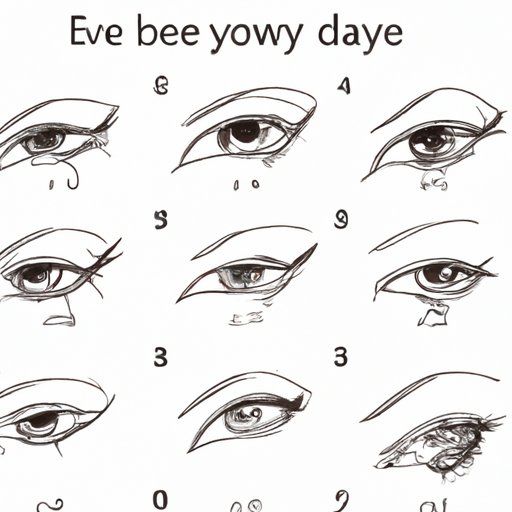
Introduction
Drawing a realistic eye can be a daunting task for beginner and expert artists alike. There are a number of factors to consider when attempting to create a lifelike eye, from the basic shapes and forms to the nuances of shading and highlighting. However, with the right tools and techniques, anyone can draw a realistic eye that captures the beauty and complexity of this amazing feature.
In this article, we offer a comprehensive guide to help you draw a realistic eye. From the materials you need to the step-by-step process, tips and tricks, reference images, and challenges, we cover everything you need to create an eye that looks like it belongs on a real human face.
Beginner’s Guide
Before you start drawing, it’s important to gather the right materials. While some artists prefer to stick with traditional pencil and paper, others may opt for digital tools. Here are the basic materials:
- Paper or tablet screen
- Pencil or stylus pen
- Eraser
- Ruler, compass, or other drawing tools for measurements and outlines
- Reference image of an eye for inspiration and guidance
The next step is to familiarize yourself with the basic shapes and forms of an eye. Break it down into its most basic components: the eyelid, iris, pupil, and surrounding area. Learn to draw each element separately before attempting to put it all together.
Positioning and proportion are also crucial. Make sure to measure out the dimensions of each part of the eye, from the height and width of the eyelid to the size and position of the iris and pupil.
The initial outlining technique is an important part of the process. Draw the outline of the eye and then add in the eyelid, iris, and pupil. Don’t worry about adding shading or details at this stage. Get all of the elements in place before moving on to the next step.
Step-by-Step Guide
Once you have the basic shapes and forms down, it’s time to start drawing a realistic eye. Follow these steps:
- Sketch the outline of the eye using a light pencil line. You can use an oval or almond shape for the outline.
- Add the eyelid by drawing a curved line over the upper part of the outline.
- Draw the iris and pupil. The iris sits at the bottom of the eyelid, and the pupil is usually a small dot in the center of the iris.
- Add the eyelashes by drawing thin, curved lines along the upper and lower eyelids.
With the basic elements in place, it’s time to add shading and details. Use varying shades of pencil to create depth and dimension. The area around the iris should be slightly darker than the rest of the eye. For highlights, leave a small circle or oval near the center of the iris, which will give the appearance of reflection.
When it comes to the eyelashes, use light, quick strokes that taper as you move toward the tips.
Keep in mind that for a realistic eye, it’s important to observe the details of a real eye closely.
Video tutorial
For a more interactive experience, you can also check out our video tutorial on how to draw a realistic eye. This video walks you through each step of the process and includes additional tips and techniques to help you create a lifelike eye.
Tips and Tricks
- Use a sharp pencil or stylus to create clean, precise lines.
- When shading, start with lighter tones and gradually build up to darker shades.
- Don’t be afraid to blend, smudge, or erase as needed.
- Experiment with different types of pencils to create different effects.
- Use reference images to help you identify details that you may not have noticed on your own.
- Practice drawing eyes from different angles and with different expressions to improve your skills.
Reference and Inspiration
For more inspiration and guidance on how to draw a realistic eye, take a look at the following resources:
- Online art websites such as DeviantArt and Pinterest
- Drawing books or tutorials
- Real-life references such as photographs or subjects
Challenges and Exercises
Improve your skills and challenge yourself with the following exercises:
- Draw an eye from memory without using a reference image. Then, compare your drawing to a real eye and identify areas for improvement.
- Draw an eye in extreme close-up, focusing on the details that are often overlooked.
- Draw an eye from different angles, such as a three-quarter view or from the side.
- Practice different styles of drawing eyes, such as cartoon, anime, or realistic.
Common Mistakes and How to Avoid Them
Here are some of the most common mistakes that beginners make when drawing a realistic eye:
- Incorrect proportions
- Failure to observe the details of a real eye
- Overuse of outlines and underuse of shading
- heavy shading in the wrong areas
To avoid these mistakes, focus on accuracy, observe closely, and practice regularly.
Conclusion
With the right tools, techniques, and practice, anyone can learn to draw a realistic eye. Remember to start with the basic shapes and forms, use reference images and guides to help you, and practice regularly to improve your skills. Stay patient, keep experimenting, and most importantly, enjoy the process of creating something beautiful and unique.





